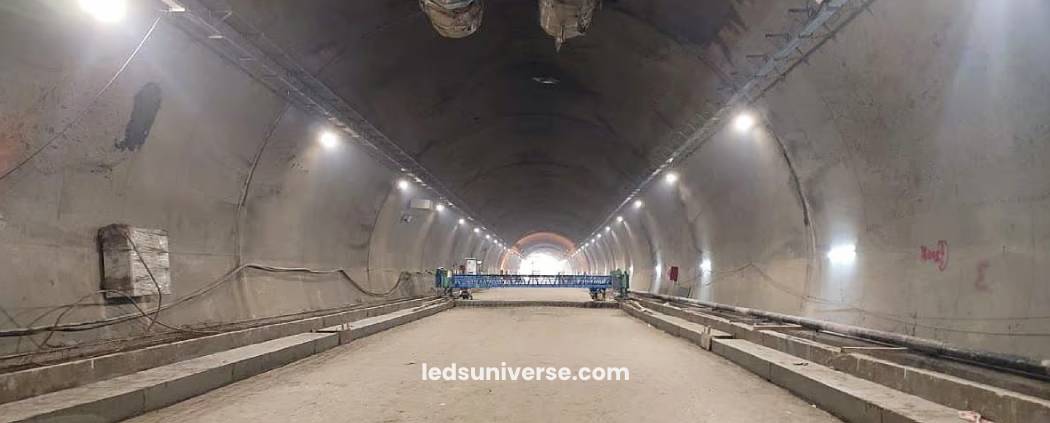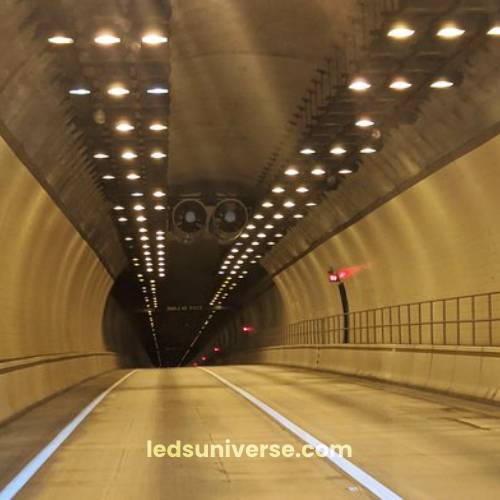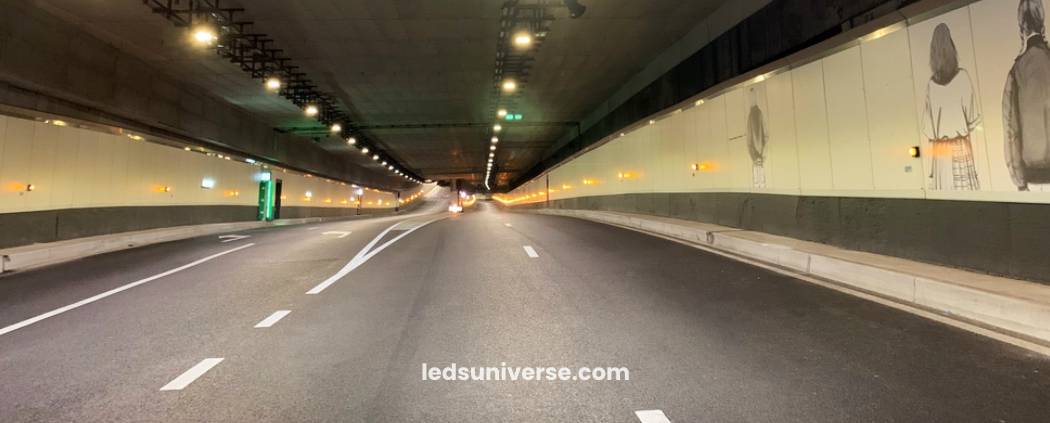Tunnel lighting involves significant costs, from installation to ongoing energy consumption and maintenance. While upfront installation expenses can vary based on tunnel size and lighting technology, energy-efficient LED systems offer long-term savings. Regular inspections and preventative maintenance programs help reduce repair costs and ensure safety. Despite the higher initial investment, LED lighting and smart energy management significantly lower long-term operating expenses, making them a cost-effective solution for tunnel operators.
Lighting in tunnels is an indispensable aspect of modern infrastructure, ensuring safety and visibility for motorists and pedestrians. However, tunnel lighting systems come with considerable financial implications, encompassing initial installation, maintenance, and energy costs. In this article, we will break down the various costs associated with tunnel lighting, from installation to ongoing maintenance and energy consumption. Understanding these expenses is vital for managing the long-term financial aspects of tunnel infrastructure.
Reach out for free lighting consultation
Table of Contents
Toggle| Tunnel Type | Estimated Installation Cost | Factors |
|---|---|---|
| Small Urban Tunnel | $100,000 – $500,000 | Short length, simple design, fewer fixtures. |
| Large Highway Tunnel | $5 million – $10 million | Longer length, complex design, more fixtures. |
| Undersea Tunnel | $5 million – $20 million | Specialized equipment, harsh environment, custom lighting. |
| Gotthard Base Tunnel | $20 million (lighting only) | Long tunnel, advanced lighting, complex design. |
| Channel Tunnel | $40 million (lighting only) | Dual rail and road, advanced systems, challenging construction. |
| Small Pedestrian Tunnel | $100,000 – $250,000 | Short length, basic lighting needs. |
The installation of tunnel lighting is a multifaceted process that requires considerable investment and technical expertise. The costs associated with installing lighting systems in tunnels depend on several factors such as the tunnel’s size, the lighting technology selected, the complexity of the tunnel’s design, and the region in which it is located. A well-designed and efficiently installed lighting system is crucial for ensuring the safety of drivers and pedestrians, making it an integral part of tunnel infrastructure projects. The financial outlay for installing tunnel lighting can vary widely, from a few hundred thousand dollars to several million.

One of the most significant factors affecting the cost of tunnel lighting installation is the overall design and structural characteristics of the tunnel. Each tunnel has unique features, such as length, width, curvature, and elevation, that require customized lighting solutions. A straight tunnel will have a different lighting setup compared to a curved one, and tunnels with high ceilings may require more lights for adequate coverage.
 The size of the tunnel plays a significant role in determining the number of lighting fixtures needed and the overall infrastructure required for installation. Larger tunnels, such as those on highways or deep undersea tunnels, will require more lighting fixtures, wiring, and control systems to ensure proper illumination across the entire span of the tunnel. In contrast, smaller tunnels, such as those in urban settings or short underpasses, may need fewer fixtures and less complex installation.
The size of the tunnel plays a significant role in determining the number of lighting fixtures needed and the overall infrastructure required for installation. Larger tunnels, such as those on highways or deep undersea tunnels, will require more lighting fixtures, wiring, and control systems to ensure proper illumination across the entire span of the tunnel. In contrast, smaller tunnels, such as those in urban settings or short underpasses, may need fewer fixtures and less complex installation.
For example, a typical urban tunnel with a length of around 1,000 feet and standard lighting requirements could cost around $200,000 to $500,000 for installation. On the other hand, a large highway tunnel stretching several miles and requiring specialized lighting for different sections (entrances, middle, and exits) can easily push the cost up to $10 million or more.
The choice of lighting technology is another significant determinant of the installation cost. Traditional lighting technologies, such as high-pressure sodium lamps or fluorescent lights, are often less expensive to install but have higher operational costs due to energy consumption and more frequent maintenance. In contrast, newer, energy-efficient technologies such as LEDs may have higher upfront installation costs but offer long-term savings in energy and maintenance.
LED systems, for instance, tend to be more expensive initially, but they require fewer fixtures and last significantly longer than conventional options, which makes them an increasingly popular choice for tunnel lighting. Installing an LED system might cost about $1,000 to $1,500 per fixture, whereas older systems like high-pressure sodium lamps may cost $700 to $900 per fixture.
Tunnels located in regions with specific requirements, such as seismic zones or areas with extreme weather conditions, may incur additional costs for specialized equipment or protective housing for lighting fixtures. In some cases, lighting systems must be designed to withstand corrosion, moisture, or extreme temperatures, particularly in coastal or underground tunnels.

Labor and construction costs are also significant contributors to the total installation price of tunnel lighting. The need for specialized contractors who are experienced in tunnel construction and lighting system installation can add substantially to the cost. The complexity of the tunnel’s layout, including whether it is a straight or curved design, will further affect labor requirements. Additionally, tunnels with more intricate designs, such as ventilation shafts or emergency exits, may require additional labor to install the necessary electrical infrastructure.
The cost of skilled labor varies based on location, but it typically ranges from $50 to $150 per hour for electricians and construction workers. For larger projects, this can result in hundreds of thousands of dollars in labor costs. For instance, in regions where tunnels are deep underground or in coastal locations, labor costs could be on the higher end due to the need for specialized skills and safety precautions.
Moreover, the time required for installation is another consideration. A simple tunnel installation may take a few months, while more complex projects may take over a year to complete, depending on the size of the tunnel and the intricacies of the design. Longer project durations increase both labor and equipment costs, leading to higher total expenses.
On average, the cost of installing tunnel lighting can range from $100,000 to several million dollars, depending on various factors such as the tunnel’s size, location, and the lighting system chosen. Smaller urban tunnels, such as those found in metropolitan areas, typically fall on the lower end of the spectrum. These tunnels often have simpler designs and may not require as much infrastructure, resulting in lower installation costs. For instance, a short, urban tunnel may incur costs as low as $150,000 to $400,000 for lighting installation.
However, the costs for larger tunnels, especially those on highways or undersea tunnels, can escalate significantly. Large highway tunnels with complex lighting systems can cost upwards of $5 million to $10 million or more for installation. A deep-sea tunnel or a tunnel with specialized safety features may push costs even higher.
To better illustrate the potential cost ranges, let’s examine some case studies of tunnel lighting installation projects. The installation of the Gotthard Base Tunnel in Switzerland, one of the world’s longest railway tunnels, required significant investment. The project included state-of-the-art lighting systems for safety, signaling, and operational efficiency. The total installation cost for the lighting system in the Gotthard Base Tunnel was estimated to be in the region of $20 million, reflecting the tunnel’s massive size and complexity.
Similarly, the Channel Tunnel, which connects the United Kingdom and France, required the installation of lighting systems capable of handling both rail and road traffic. The installation of lighting and associated electrical systems in this 31-mile-long tunnel was a multi-million dollar project. The lighting installation cost for the Channel Tunnel alone was estimated at over $40 million, driven by the extensive safety measures and the harsh underground environment.
In contrast, smaller tunnels, such as those used for local roads or pedestrian pathways, might cost far less. The installation of lighting in a 500-foot-long underpass in a major city might only cost between $100,000 and $250,000, depending on the type of lighting system selected.
Energy consumption is a significant ongoing expense for tunnel lighting systems. The amount of energy used depends on several factors, including the type of lighting technology, the size and design of the tunnel, and how long the lights are operational each day. Managing these costs is crucial for ensuring long-term sustainability and efficiency in tunnel operations.
Over the past few decades, tunnel lighting technology has undergone significant advancements, shifting from traditional lighting systems to more energy-efficient solutions. Sodium vapor lamps, once commonly used for tunnel lighting, have been largely replaced by LEDs (light-emitting diodes), which offer significant reductions in energy usage while still providing the necessary illumination.
For example, sodium vapor lamps typically consume around 400 watts per fixture, whereas an LED fixture with similar brightness may only use around 150 watts. This transition to LED lighting can cut energy consumption by up to 50%, depending on the tunnel’s specific requirements. This reduction in energy consumption not only lowers energy costs but also reduces the environmental impact associated with tunnel lighting.
The cost savings from adopting LEDs are substantial over time. While the initial investment in LED lighting systems may be higher than traditional options, the long-term savings in energy costs can be considerable. For larger tunnels, these savings can amount to hundreds of thousands of dollars annually, which makes LEDs a highly cost-effective solution in the long run.
The duration for which a tunnel is illuminated each day is another important factor in determining energy costs. Tunnels in busy urban areas or along highways often require lighting to be on 24 hours a day to ensure safety and visibility. These high-traffic tunnels may need constant lighting regardless of the time of day. In contrast, tunnels in less busy or remote locations may only require lighting during certain hours, such as nighttime or during periods of low traffic.
The more hours a tunnel is illuminated, the higher the associated energy costs. For instance, tunnels that operate around the clock will incur higher annual energy expenses than those with limited lighting hours. To address this, many modern tunnel systems are equipped with sensors and automated control systems that adjust lighting levels based on traffic flow and time of day.
These automated systems help optimize energy use by dimming lights or turning them off entirely during periods of low traffic. For example, in tunnels with low traffic at night, the lighting can be reduced by 50% or more, contributing to a significant reduction in energy consumption. The use of such smart technologies can save energy, lower operational costs, and increase the overall efficiency of tunnel lighting systems.
The energy costs for tunnel lighting can vary widely based on several factors, including the tunnel’s size, location, and traffic volume. In general, smaller tunnels in areas with lower energy costs may have relatively modest energy expenses. However, larger tunnels, especially those in high-traffic areas, can incur significantly higher energy costs.
On average, annual energy costs for tunnel lighting can range from approximately $50,000 to over $500,000. Smaller tunnels or those with limited usage might fall on the lower end of this range, while larger tunnels with high traffic volumes and 24-hour operation will likely see much higher energy costs. In some cases, the costs for lighting in high-traffic tunnels can exceed $1 million per year, especially if energy-efficient technologies are not employed.
The maintenance of tunnel lighting systems is an ongoing expense that must be considered for long-term tunnel infrastructure planning. Over time, lighting systems degrade, bulbs burn out, and components may need repair or replacement. Proper maintenance is vital to ensure safety and operational efficiency, making it a significant part of the overall cost of tunnel lighting.
Routine inspections are crucial for maintaining the proper functioning of tunnel lighting systems. Regular checks are necessary to identify issues before they lead to lighting failures, which could present safety risks. The frequency of inspections depends on the type of lighting system used and the environment in which the tunnel is located.
Older systems, like high-pressure sodium lamps, typically require more frequent bulb replacements and more intensive inspections, leading to higher maintenance costs. On the other hand, newer lighting technologies such as LEDs are designed to last longer and need less frequent attention. However, even LEDs, despite their longer lifespan, still require occasional maintenance, such as fixture inspections, wiring checks, and cleaning to ensure optimal performance.
The cost of maintaining tunnel lighting systems can vary significantly based on tunnel size, lighting technology, and accessibility. For smaller tunnels, maintenance costs may range from a few thousand dollars annually. Larger, more complex tunnel systems with high-intensity lighting or difficult access points can incur much higher expenses, often reaching several hundred thousand dollars per year.
In traditional lighting systems, replacing bulbs can be a costly process, especially in tunnels that are difficult to access. The labor and equipment required for bulb replacement and repairs contribute to the higher expenses. In more challenging environments, such as tunnels with high ceilings or in remote locations, these costs can escalate further due to the need for specialized equipment like cranes or scaffolding.
LED systems, while reducing the frequency of bulb replacements, still incur maintenance costs. These include cleaning the fixtures, checking electrical components, and occasional part replacements. Nevertheless, because of their longer lifespan and reduced maintenance needs, LED systems are typically less expensive to maintain in the long run compared to older technologies.
Many tunnel operators choose to implement preventative maintenance programs to reduce unexpected repair costs and extend the lifespan of their lighting systems. These programs involve regular checks and early replacements of components before they fail, helping to avoid more expensive emergency repairs. A preventative maintenance program may cost anywhere from $10,000 to $100,000 annually, depending on the size and complexity of the tunnel.
Although these programs represent an upfront cost, they help ensure the tunnel lighting system operates smoothly and efficiently. By addressing potential issues before they escalate, preventative maintenance can reduce overall repair expenses, minimize downtime, and improve the safety and reliability of the tunnel lighting.
As technology advances, tunnel operators may decide to replace or upgrade their lighting systems to take advantage of newer, more efficient technologies. Replacing older lighting systems with modern solutions, such as LED technology, can be a significant upfront investment but can yield substantial long-term savings.
The shift toward LED technology has been one of the most common upgrades in tunnel lighting. While the initial cost of retrofitting a tunnel with LED fixtures can be expensive, the long-term benefits in terms of energy savings and reduced maintenance costs can offset these costs. The typical cost of upgrading a single tunnel with new LED lighting can range from $250,000 to $2 million, depending on the tunnel’s size.
Upgrading lighting systems often involves integrating new technology into existing infrastructure. This could include installing sensors, automating lighting controls, or upgrading power supply systems to accommodate new types of lights. These integrations can lead to additional costs, but the added efficiency and safety benefits are usually worth the investment.
When considering tunnel lighting expenses, it is essential to plan for both short-term and long-term financial needs. The upfront costs of installation and upgrades must be weighed against the long-term savings in energy and maintenance. Financial planning should account for factors such as the tunnel’s size, traffic volume, and the anticipated lifespan of the lighting systems.
In addition to initial installation and upgrade costs, ongoing expenses like energy consumption and maintenance should be factored into long-term budgeting. A comprehensive financial plan should consider potential cost fluctuations, including rising energy prices or unexpected maintenance requirements.
Given the high initial costs associated with tunnel lighting, many governments and organizations choose to finance these projects through bonds, loans, or public-private partnerships. These financing options allow for the spread of expenses over time, making the investment in tunnel lighting more manageable for municipalities and agencies responsible for maintaining tunnels.
The expenses associated with tunnel lighting are multi-faceted, encompassing installation, energy consumption, maintenance, and possible upgrades. While the initial installation costs can be substantial, opting for energy-efficient lighting solutions, such as LED systems, can offer long-term savings in energy and maintenance costs. Strategic planning, including regular maintenance and potential system upgrades, is essential for managing the ongoing financial implications of tunnel lighting.